ECS LIVA Q3D and ACEMAGIC T8 Plus micro-PCs Review: Jasper Lake and Alder Lake-N in a Smaller-than-UCFF Package
by Ganesh T S on September 21, 2023 9:10 AM EST- Posted in
- Systems
- Intel
- ECS
- LIVA
- Jasper Lake
- Alder Lake-N
- AceMagician
- micro-PC
System Performance: Multi-Tasking
One of the key drivers of advancements in computing systems is multi-tasking. On mobile devices, this is quite lightweight - cases such as background email checks while the user is playing a mobile game are quite common. Towards optimizing user experience in those types of scenarios, mobile SoC manufacturers started integrating heterogenous CPU cores - some with high performance for demanding workloads, while others were frugal in terms of both power consumption / die area and performance. This trend is now slowly making its way into the desktop PC space. However, both systems we are looking at today - the LIVA Q3D and the T8 Plus employ only the frugal cores.
Multi-tasking in typical PC usage is much more demanding compared to phones and tablets. Desktop OSes allow users to launch and utilize a large number of demanding programs simultaneously. Responsiveness is dictated largely by the OS scheduler allowing different tasks to move to the background. The processor is required to work closely with the OS thread scheduler to optimize performance in these cases. Keeping these aspects in mind, the evaluation of multi-tasking performance is an interesting subject to tackle.
We have augmented our systems benchmarking suite to quantitatively analyze the multi-tasking performance of various platforms. The evaluation involves triggering a ffmpeg transcoding task to transform 1716 3840x1714 frames encoded as a 24fps AVC video (Blender Project's 'Tears of Steel' 4K version) into a 1080p HEVC version in a loop. The transcoding rate is monitored continuously. One complete transcoding pass is allowed to complete before starting the first multi-tasking workload - the PCMark 10 Extended bench suite. A comparative view of the PCMark 10 scores for various scenarios is presented in the graphs below. Also available for concurrent viewing are scores in the normal case where the benchmark was processed without any concurrent load, and a graph presenting the loss in performance.
| UL PCMark 10 Load Testing - Digital Content Creation Scores | |||

| UL PCMark 10 Load Testing - Productivity Scores | |||

| UL PCMark 10 Load Testing - Essentials Scores | |||
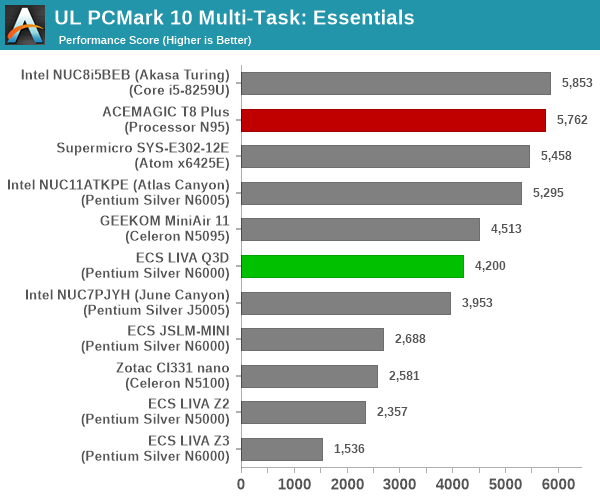
| UL PCMark 10 Load Testing - Gaming Scores | |||

| UL PCMark 10 Load Testing - Overall Scores | |||

Since none of the systems being considered in the graph above have heterogeneous cores, it is no surprise that the relative ordering of various systems remains the same irrespective of the presence of concurrent loading.
Following the completion of the PCMark 10 benchmark, a short delay is introduced prior to the processing of Principled Technologies WebXPRT4 on MS Edge. Similar to the PCMark 10 results presentation, the graph below show the scores recorded with the transcoding load active. Available for comparison are the dedicated CPU power scores and a measure of the performance loss.
| Principled Technologies WebXPRT4 Load Testing Scores (MS Edge) | |||
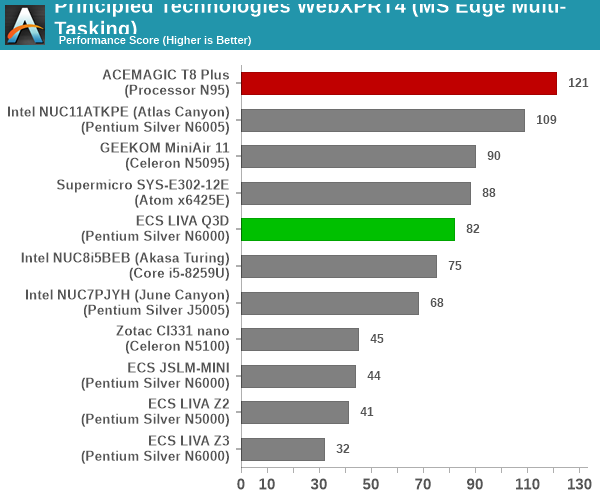
In the absence of thermal throttling, the systems have minimal performance loss. The ones with a higher PL1 / PL2 value fare better in that aspect.
The final workload tested as part of the multitasking evaluation routine is CINEBENCH R23.
| 3D Rendering - CINEBENCH R23 Load Testing - Single Thread Score | |||
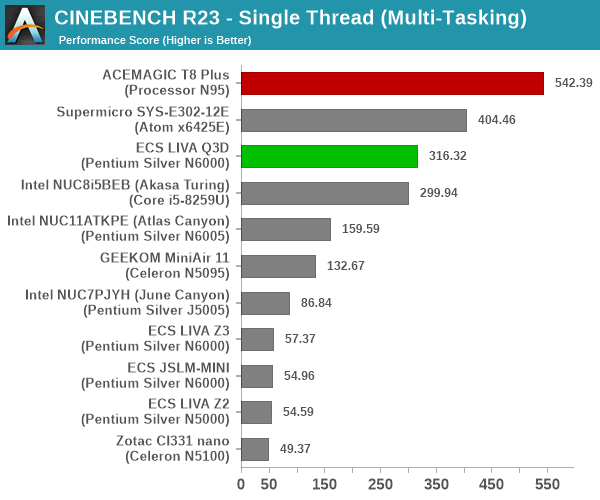
| 3D Rendering - CINEBENCH R23 Load Testing - Multiple Thread Score | |||
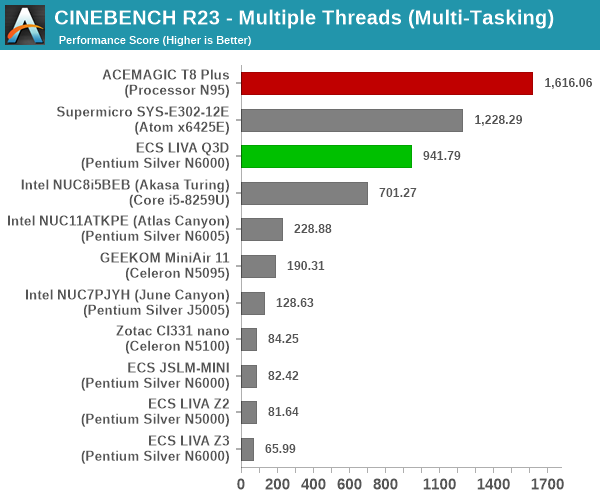
Similar to software transcoding, rendering is also quite CPU intensive with barely any recovery time possible for the CPU between operations. Therefore, it is no surprise that loss in performance ranges from 35% to 90%. A look at the impact to the transcoding rate during this segment would provide more insight on how the system handles concurrent workloads.
After the completion of all the workloads, we let the transcoding routine run to completion. The monitored transcoding rate throughout the above evaluation routine (in terms of frames per second) is graphed below.
| ACEMAGIC T8 Plus (Intel Processor N95) ffmpeg Transcoding Rate (Multi-Tasking Test) | |||
| Task Segment | Transcoding Rate (FPS) | ||
| Minimum | Average | Maximum | |
| Transcode Start Pass | 0 | 3.75 | 18.5 |
| PCMark 10 | 0 | 2.89 | 14 |
| WebXPRT 4 | 1 | 3.5 | 7 |
| Cinebench R23 | 0 | 1.99 | 7 |
| Transcode End Pass | 0 | 3.76 | 15.5 |
A similar set of results for the LIVA Q3D is presented below.
| ECS LIVA Q3D (Intel Pentium Silver N6000) ffmpeg Transcoding Rate (Multi-Tasking Test) | |||
| Task Segment | Transcoding Rate (FPS) | ||
| Minimum | Average | Maximum | |
| Transcode Start Pass | 0 | 1.99 | 14.5 |
| PCMark 10 | 0 | 1.42 | 7 |
| WebXPRT 4 | 0 | 1.53 | 4.5 |
| Cinebench R23 | 0 | 1.32 | 4 |
| Transcode End Pass | 0 | 1.95 | 8.5 |
The absolute numbers for the T8 Plus are much better than that of the LIVA Q3D, as expected from a newer generation system. The actual delta in the Cinebench segment is therefore worse for the T8 Plus compared to the LIVA Q3D, but the absolute numbers end up making for a better user experience with the ADL-N system under these types of loading conditions.


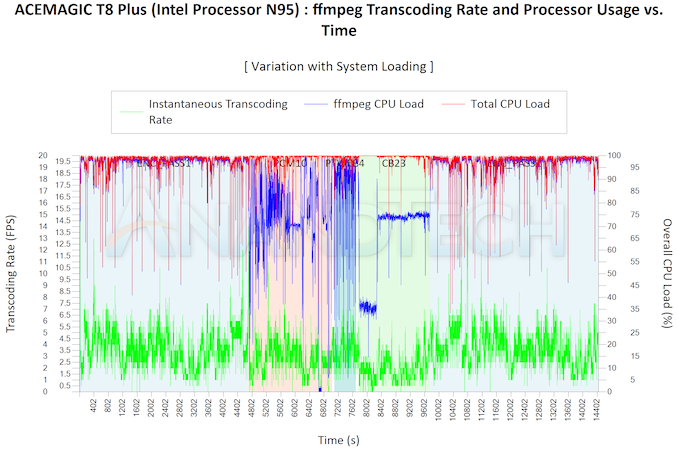
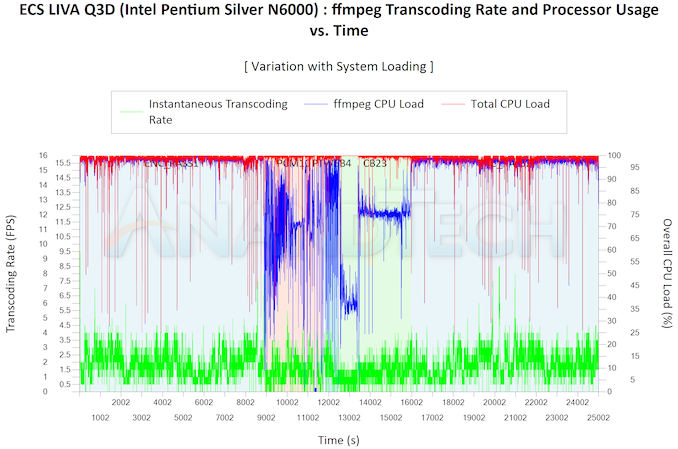








8 Comments
View All Comments
ballsystemlord - Thursday, September 21, 2023 - link
@Ganesh , Your pricing info makes it appear as though the coupon itself saves us $177. Please consider removing the "-" (minus) sign, use a comma or a semicolon instead.Samus - Thursday, September 21, 2023 - link
I'm just waiting for someone to chime in about how the Apple M2 is so much faster... XDballsystemlord - Friday, September 22, 2023 - link
Well, we can't disappoint you so...meacupla - Friday, September 22, 2023 - link
I too have never seen that SSD controller/nand maker.HGO? HSO?
That logo looks too similar to HOS from Patlabor
mode_13h - Monday, October 2, 2023 - link
Except that Labors, like Chobits, clearly had hard disks.sjkpublic@gmail.com - Friday, September 22, 2023 - link
Missing a proper NVME connection / controller? Looks like fastest disk speed is 600 MB/s.t.s - Sunday, September 24, 2023 - link
Thanks for the review.From the idle power side, it's quite high, cause my HP elitedesk 800 G4 65 watt can go as low as < 4W with i5-8500T. Asrock Deskmini x300 with ryzen 5700G is about ~12w idle. All measured from the wall.
mode_13h - Monday, October 2, 2023 - link
Let me know when there's a reasonably-priced (i.e. not industrial) Alder Lake-N mini-ITX board with DDR5 support. So far, I've yet to find one.